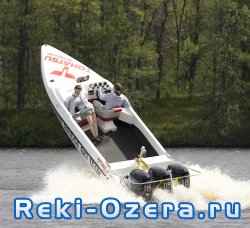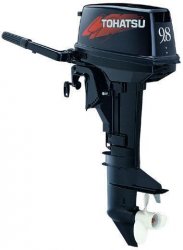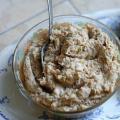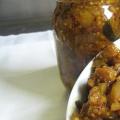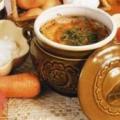|
|
|
|
|
|
|
|
|
|
|
Before buying a boat with a motor, the question often arises of which motor to choose. Some shops in Yekaterinburg advise that the motor should be of the maximum power that is provided for a given boat. This is too one-sided, let's look at this issue from several angles.
Manufacturer country.
There are several countries whose engines are sold in Yekaterinburg. These are the USA, China, Russia and Japan. We cross out Russia (if we don’t want to row 20 km to a car parking lot; besides, our engines are the hardest to find for sale new), we are suspicious of China and boldly take any brand from the USA or Japan. There is talk about Tohatsu being more reliable, Yamaha being quieter, Honda being more technologically advanced, but this is more a matter of taste. The main thing is that the engine rows in accordance with its horses and does not break down, right? In terms of price, foreign cars are approximately the same, only Honda engines are significantly higher than their counterparts of the same type.
For further discussion we will need to understand what is planing?
Planing is a sailing mode when the boat, upon reaching a certain speed, rises slightly out of the water, while its resistance to water decreases and speed increases. Engine speed increases according to speed. Despite the increase in engine speed, the planing mode is considered economical, because Significantly less gasoline is spent on overcoming water resistance.
The bow of the boat raised up is NOT planing. When planing, the boat runs parallel to the plane of the reservoir and the bow is only slightly raised, and even then, if there is no passenger or cargo in front. A PVC boat goes on planing at a speed of approximately 15 km per hour and above, depending on the wind, waves, load, shape, type of bottom, etc. An all-metal boat requires a little more speed.
Boat motor power.
Outboard motors produce power from 2x to 300 Horse power. Which one do you need?
Boat motors 2-6 hp
These are single-cylinder “rattlers” designed to move you through the water at a speed of 5-10 km/h. Please note that this speed is greatly affected by currents, headwinds and additional load. As a result, it is easy to stand still on such a motor. You can’t imagine how boring such a voyage can turn into. The habitat of such motors is small lakes, or coastal fishing on large lakes and calm rivers. Crossing Ayatskoye or Tavatuy with such a motor is a very long undertaking, taking an hour to an hour and a half of sailing. Yes, such motors consume little and also weigh little, which cannot but please the public with lower back pain. It is important that the engines have 5 hp. and you don’t need to take any less for your driving license.
In planing mode, motors are 2-4 hp. will not be able to get out under any circumstances, about 5-6 hp engines. there are some reviews on this topic, but only in one, on calm water and without any load and at full throttle and without guarantees. When operating at full throttle for a long time, the engines quickly wear out, and idling is extremely unstable due to the presence of only one cylinder.
Boat motors 8-15hp.
Typically, such outboard motors are already two-cylinder, which gives significant stability in operation, especially at idle. These motors weigh 30-35 kg for one person, but in order not to fall into the category of fishermen with a torn lower back, it is better to move them together.
Such motors are capable of bringing the boat to planing - motors of 8-10 hp. one with a load and two without a load, 15 hp motors - two with a load. By load I mean more than 100kg. Such motors are ideal for boats with a length of 300-360 cm. You won’t be able to take a friend on skis with such a motor, but for reaching remote areas of reservoirs, multi-day, relatively fast and at the same time economical movements, such motors are very suitable. Fuel consumption at ¾ turn of the throttle is 4-6 liters per hour. When moving in trolling mode, 10 liters is enough for the whole day. It is the motors of this power range that are universal in terms of planing and simultaneous (in the sense of the same motor) trolling capabilities, that is, movement at speeds from 3 to 30 km/h. The price of such motors made in Japan is 60-80 thousand.
Boat motors over 20 hp
Amateur fishermen PVC boats in the Sverdlovsk region they are used quite rarely due to inefficiency, unnecessary power and large mass. And they also cost a lot, already about 80-100 thousand rubles.
What goals do such motors help achieve: To give a breeze to three or four people, and with a power of more than 30 hp. take a water skier for a ride.
Typically motors are over 20 hp. They are installed on all-metal boats, without counting on regular transportation of the motor separately from the boat.
Particularly advanced water-motor fishermen have two motors per boat - with a 25 hp motor. they move around the pond, with a 5 hp motor. they fish by trolling. A powerful motor at idle is not able to provide the speed required for trolling.
Two-stroke or four-stroke engine.
Without going into the theory of how two and four strokes work, I’ll explain that a two-stroke engine, compared to a four-stroke engine, consumes about 20% more fuel, requires pre-mixing of oil and gasoline, is noisy (like a motorcycle) and runs unevenly, BUT weighs 20 percent less -30% (and this can be 10-20 kg), cheaper to maintain, does not require pouring oil into the crankcase, can be transported in any position.
Like two-stroke, four-stroke engines are produced with a power of 2 hp. Therefore, if you are a tourist-angler-waterman constantly moving around different bodies of water, recognizing only wild fishing spots that are not equipped with comfortable access to the water, then an unpretentious two-stroke engine will be the best choice. By the way, a two-stroke engine in idle mode, according to many experts, does not in any way affect the quality of trolling fishing. The fish doesn't pay attention to this.
Accordingly, a four-stroke motor is perfect for boaters who can afford not to regularly carry a motor in the trunk, or transport it on a trailer rigidly attached to a frame boat. And also, a boat with a motor can be stored on the water all summer, for example, in the parking lot of the base on Lake Ayatskoye. True, there have been no fish there for a long time, although the lake seems promising.
Engine fixation.
Important parameter. The engine in forward motion must be able to be rigidly fixed to the transom. The engine is clearly attached to the transom itself with clamps, but still has free movement, that is, it can be raised or lowered into the water, so to speak. So, this very function has two sides. When hitting an underwater obstacle, the engine rises and with minimal damage everyone is happy. However, on the waves, which on our lakes, it turns out, can be rather large for PVC boats, the engine begins to lift and then hit the transom, which is not good. For example, the Tohatsu 9.8 engine does not have such a mount, but the Yamaha 15 hp does. But God forbid you run into an obstacle with the engine fastened. It’s better to let it hit the transom in the waves if you are not ready to constantly control the depth, or are moving along an unfamiliar river. Drowning the engine in this case can be called the most favorable outcome.
Engine tilt levels.
Sometimes, at shallow depths, you want to swim under the motor, but the keel of the motor is already touching the bottom. For such cases, various engine tilts are provided, which are called shallow mode. In addition to the highest and lowest positions, there is at least one intermediate shallow position. There are three, which is naturally better and more convenient.
Let's return to the question again. The lineup Each manufacturer updates itself almost every year, and the market situation generally changes, so every year this dilemma has surfaced and will continue to emerge. And now the season is starting very soon and now is the time to think about what you can buy for yourself at a good price, because... Now all stores selling water-powered equipment offer all types of propulsion systems with good discounts. So don't put it off until later, it's time to buy.
I would like to remind you that for each, so to speak, task you need to choose your own outboard motor. It is necessary to take into account not only the size of your boat or boat, but also where and in what modes the outboard motor will be used. For difficult conditions there are its analogues; for shallow waters you need to choose a water cannon. And the most common mistake is choosing a low-power motor for a heavy boat. On the one hand, you saved and bought cheaper, and on the other, your engine will always operate at maximum speed, which will ultimately lead to rapid wear of its main components and assemblies and, as a result, repairs that can result in such amounts that will not pay for your initial savings.
Our selection of outboard motors
Today we decided to consider the most popular models of outboard motors on the Russian market, both two-stroke and four-stroke. The power range from 2 to 20 hp was chosen, because... he is the most in demand. All this was divided into five groups with several models in each. Today we are not looking for the best motor for this or that characteristic, but we choose, so to speak, “on the topic of the day”, for which we would have enough money if we had any at all. It is clear that Japanese and American outboard motors will always be beyond competition. Today we have many examples of Chinese engine manufacturing here. Don’t blame me, this is life today and this is the exchange rate of the ruble against the dollar.
We would like to make a reservation right away - perhaps your favorite motor will not be included in this list, sorry, this is our choice. Welcome to the comments for discussion.
Table No. 1 - The best outboard motors in terms of price/quality ratio
| Category | Name | average price |
|---|---|---|
| Boat motors up to 5 hp | HDX T 2.6 CBMS | 16 500 |
| Two-stroke engines 5 hp | Toyama TM5TS | 49 000 |
| HDX T 5 BMS | 40 000 | |
| Four-stroke engines 5 hp | Honda BF5AK2 SU | 80 000 |
| Honda BF5A4 SBU | 84 000 | |
| Mercury ME F 5 M | 72 000 | |
| Toyama TM5FS | 57 000 | |
| HDX F 5 BMS | 50 000 | |
| Boat motors up to 10 hp | Mercury ME F 9.9 M | 144 000 |
| Hidea HD9.8FHS | 67 000 | |
| Boat motors from 15 to 20 hp. | Honda BF20D3 SHSU | 220 000 |
| Suzuki DF20AS | 160 000 |
HDX T 2.6 CBMS
From the motor markings it is clear that its power is 2.6 hp. (50 cc working volume), which gives it the ability to accelerate with a length of 3 meters and with one rider an average of 10 km/h. The maximum consumption was recorded at 1.3 l/hour. You may have different data, but this is what we have. The motor's light weight of 9.8 kg makes it easy to carry and install on the boat alone. Easy to maintain. Equipped with a 3-bladed aluminum propeller. The exhaust is organized through a propeller. There are only two speeds, neutral and forward, there is no reverse, so to move backward you will have to turn the motor 180 degrees. The motor is assembled in China. The average price in Russia is 16,500 rubles.
Advantages:
- Easy to start in any weather conditions
- Good traction for its power
- Suitable for use in shallow water, but still need to be careful.
- Built-in fuel tank 1.2 l.
Flaws:
- The throttle handle on the tiller is kind of flimsy, it's plastic, it's about to break
The best two-stroke outboard motors 5 hp.
Toyama TM5TS
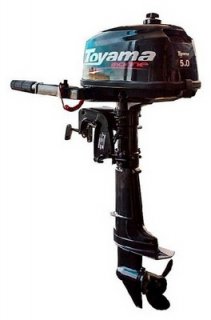
Although the Toyama brand is Japanese, all outboard motors of this brand are now assembled exclusively in China for the Russian market. But despite our prejudices, this one turned out to be quite reliable and productive. Most likely, it is based on an old Japanese engine, slightly modified to meet modern requirements. Quite easy to maintain. The average price is 49,000 rubles.
According to characteristics. Low weight of 20 kg. still ok for one person to carry. Engine capacity 102 cc. Power 5 hp Push-pull. Equipped with a 3-bladed propeller 7.8 inches in diameter. There is a reverse direction. There is no electric starter, you have to pull it with a cable. Average consumption at maximum speed is more than 3 l/hour. So stock up on an external fuel tank (the built-in one is only 2.7 liters) because... gasoline will run out very quickly.
Advantages:
- Good build quality for a Chinese motor
- Normal reliability
Flaws:
- Small range when using only the built-in tank
- High price for such a motor
HDX T 5 BMS
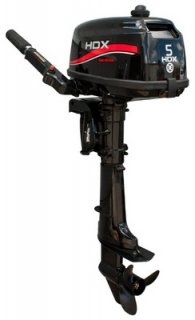
Another two-stroke Chinese outboard motor, but under the brand. In fact, it is structurally no different from the Toyama TM5TS. These are twins, with the exception of some differences that cannot be considered as advantages of the HDX T5 BMS, but more on them below.
Advantages:
- Quite reliable and productive for a Chinese
Flaws:
- Very small fuel tank of 1.5 liters. which is in no way suitable for the main consumers of this motor, fishermen and hunters, who can cover a distance of up to 30 km in a day. And with such a tank and fuel consumption, the power reserve is only 30 minutes. The engine must be equipped with an external tank of 20 liters.
- There is no propeller shutdown system. Such an unjustified simplification of the design (there is not even a shear key), even with a simple screw hooking the bottom, will at least lead to the blade being torn off, and at most will turn the gearbox around.
Choose better Toyama TM5TS, despite the higher price compared to HDX T5 BMS - 40,000 rubles.
We did not specifically consider Japanese and American outboard motors here, because... their prices start at 65,000 rubles, which is 25% more expensive than the models reviewed. It is clear that any of the “Japanese” will be better and if you have enough money, then of course it is better to buy, or.
The best four-stroke outboard motors 5 hp.
Here the main idea like this: Best 4-stroke = Honda.
Honda BF5AK2 SU
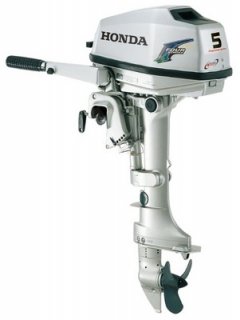
They have always been famous for their high quality, reliability, low noise and performance. The Honda BF5AK2 SU has not moved away from this either. Tiller control, almost silent and without unnecessary vibrations, is perfect for trolling fishing, because... gives confident and stable traction at minimum speeds. Excellent efficiency, we burned three liters of 95 gasoline in about 8 hours, so 2.6 l/hour. It may well pull inflatable boat up to 4 meters long. Weight 27 kg, displacement 127 cc, no electric starter.
Advantages:
- Performance and reliability, will easily last more than 10 years, without serious breakdowns, with proper care
- Economical
- Includes external fuel tank of 13 liters.
- Can swallow gasoline from octane number from 86, but it’s better, of course, to fill in at least AI-92
- Easy to operate
Flaws
- Price - average in Russia 80,000 rubles, but you have to pay for quality
Honda BF5A4 SBU

Another outboard motor from a famous Japanese brand that produces exclusively “four-stroke” engines. They have already eaten their “Japanese dog” with them, so they know a lot about quality and reliability. More specifically, it is 127 cc. volumes producing 5 hp. It can run on 92 gasoline, but it’s better to feed it with higher quality fuel to make it last longer. A 12 liter gas tank is included. A competent and extremely reliable fastening to the transom, most likely migrated here from a more powerful brother, because Looks like it's designed to carry more weight. good and simple system. An extremely comfortable tiller handle that fits securely in your hand and does not slip even in a wet or dirty hand. There is also a fuse that will stop the engine if you suddenly fall overboard. This model even has a generator, as evidenced by the letter “B” in the marking. It produces a current of 3A, which is only enough to power the LED backlight and power the echo sounder. This generator also powers the anti-corrosion protection on the trimmer.
Advantages:
- Excellent quality and reliability
- Long range with 12 liter tank
Flaws:
- Not very easy to maintain
- Price 84,000 rubles
Well, don’t forget about, this is still a four-stroke outboard engine and in the winter you need to drain all gasoline and oil from it, because The fuel system is very finely tuned and is afraid of any dirt and sediment, of which there is plenty in our gasoline.
Mercury ME F 5 M
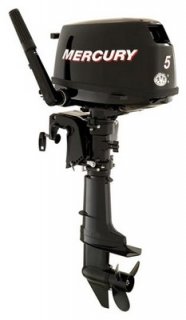
We also have in our rating the American outboard motor Mercury ME F 5 M and all with the same 5 hp. power. 123 cc volume, but the fuel tank is only 1 liter, well, what good is that, the owner will have to buy an external one. A 12-liter is available as an option, but with it the price of this engine is already off the charts. It's better to buy it somewhere yourself. There is no generator. The motor behaves well in shallow water and even with a strong tilt, the efficiency of the propeller does not drop much. True, the engine is noisy, because... the exhaust does not go through the propeller, but directly into the air.
Advantages:
- Branded four-stroke bike priced at 72,000 rubles
- Works well in shallow water
Flaws:
- Fuel tank is too small
Toyama TM5FS

Well, the Chinese have learned to make four-stroke outboard engines, or maybe they haven’t. Let's see. The Japanese brand, based on a Chinese theme, gave birth to the Toyama TM5FS, which is essentially a redesigned two-stroke engine from that same brand. Only it has become heavier (25 kg), lost the size and pitch of the propeller, and hence its dynamics are not so great. Although what kind of dynamics can you expect from 5 hp? But still.
Small working volume of 112 cubes. Small fuel tank of 1.1 liters. Small screw. Everything is small. And it must be placed, accordingly, on a small boat. Price 57,000 rubles. Something mediocre, for such an engine I would like it to be cheaper, at least not to cross the line of 50 thousand rubles.
Advantages:
- Decent build quality
Flaws:
- Weak
- "Enema" type gas tank
HDX F 5 BMS

Among the Chinese brands that supply outboard motors to our Russian market Perhaps two brands can be distinguished - this and . And just today we have a model of the HDX F 5 BMS four-stroke engine for inspection. 112 cc working volume, 5 hp capable of accelerating a small boat to 25 km/h. There is decent torque and good traction at low revs. Compared to its two-stroke brother, it is less noisy and noticeably more economical, weighing 24.5 kg. However, now we have a gas tank of only 1.3 liters, so don’t throw away your old tank, it will come in handy.
Maintainability is also excellent. Repairing this motor is no more difficult than engines from any lawn mower or cultivator, you just need to take into account water cooling. We do not recommend walking in shallow water. The water intake becomes clogged very quickly from silt and other dirt from the bottom and the cooling system stops working. So the hunters are not the same client, but the fishermen are clean water will be pleased with the HDX F 5 BMS.
Advantages:
- Economical
- Maintainability
- Dynamics
- Good price of 50,000 rubles
Flaws:
- Small gas tank
The best 10 hp boat motors.
We already talked about 10-horsepower outboard motors once in. But let's take a look again at the realities of today's prices and market conditions.
Mercury ME F 9.9 M
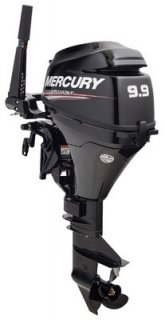
Another American on our list. Four-stroke outboard motor with a power of 9.9 hp. Not requiring any management rights. Only for our country it is quite possible to write honestly 10 hp, and not resort to such tricks, because... in our laws regarding the registration of small boats the figure appears 8 kW, and this is equal to 10.8 hp, so we would be able to meet the requirements even with ten.
As for the Mercury ME F 9.9 M itself, it is an excellent representative of thoroughbred four-stroke engines, which, even at the price (RUB 144,000), is not too far ahead. Yes, it is more expensive than its Chinese counterparts, but here you get reliability, quality and a resource that will be difficult to develop with proper use. These motors are bought for long and faithful service with the belief in excellent fault tolerance, which it more than justifies.
According to characteristics. Displacement 209 cc, two cylinders, 9-inch three-blade propeller. 12 liter gas tank, 6 amp generator. Everything you need for everyday use. Decent performance in terms of noise and vibration. Economical.
Advantages:
- Reliability, fault tolerance
- Quality
Flaws:
- It’s difficult to find and buy in our country, either to order, or buy a Chinese equivalent
Hidea HD9.8FHS

And here is the same Chinese analogue at a price 2 times lower than its American counterpart, only 67,000 rubles. What do we get for this money? 10-horsepower two-stroke outboard motor, with an engine capacity of 169 cc. Built-in 12-liter gas tank, which should be enough for 60 km. Consumption accordingly is approximately 5.5 liters per hour at full speed. It was possible to accelerate a 3.5 m long inflatable boat to 30 km/h.
In terms of maintainability and service life, the Hidea HD9.8FHS is quite a good model. The basis was to take an old engine from Tohatsu. Perfect for those who carefully count their money, but despite this want to join the motorboat community, but don’t want to get involved with it.
Advantages:
- An old Tohatsu model was used as a base
- Easy to maintain
Flaws:
- Its push-pull
The best boat motors from 15 to 20 hp.
And we have already considered this power range in. But today everything, if not changed, has been adjusted, and we now look at prices with great passion.
Honda BF20D3 SHSU
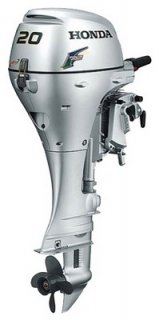
It's Honda again, which means we have a four-stroke outboard motor again. Now it's 20 hp. As expected, low fuel consumption, low noise and vibration levels, excellent traction throughout the entire rev range, but not sporty throttle response. In acceleration, two-stroke outboard motors will always outperform similar four-stroke engines.
working volume 350 cc, 2 cylinders, electric starter, 12 A generator, everything would be fine if not for the price of 220,000 rubles. But Hondas have always been expensive and they earn back every ruble invested in them, believe me. And the 20 is unlikely to be bought by people who can barely make ends meet; it is still a fairly powerful motor and it should be able to haul 4 or more meters in length. So if you want a reliable propulsion system for your boat, then welcome to Honda.
Separately, I would like to note the engine cooling system, which consists of both a pump and two water intakes, which are directed in the direction of travel, removing part of the load from that same pump. And the water intake openings are securely closed with mesh filters, almost completely eliminating the entry of foreign objects and dirt into the system.
Advantages:
- Robust design
- Resource
- This is a Honda
Flaws:
- And again the price
Suzuki DF20AS

Suzuki is one of those companies that is not afraid to experiment with the design of its outboard motors. And the Suzuki DF20AS model just confirms this rule. At a time when most manufacturers in this segment use a reliable, but still outdated fuel system based on a carburetor, Suzuki released a fuel injection engine.
The characteristics of the engine are excellent - 327 cc. volume, 20 hp power, three-bladed propeller 10 inches. Powerboat with such a propulsion, it shoots from a stop like a real racing car. It can also work quite well as a riding horse and pull a loaded ship. In addition to speed characteristics, fuel injection also provides good economy. The Lean Burn system allows the engine to run on lean mixtures without consuming excess fuel.
But not everything is so rosy for the Suzuki DF20AS. There is no electric starter, and starting the injection engine by pulling the handle is still a bummer, and if there is no battery (you can order it as an option), then it’s not very good at all. Imagine that your jerk of the handle should be such that there is enough current for the generator, injection ECU, fuel pump. For a carburetor engine, a small amount of shaft rotation was always enough for everything to work. Injection also requires additional complex electronics, which can fail, especially considering that it is operated in an environment with high humidity. The first years of production of this model there was a large percentage, about 25% of failures, which is a lot for such a famous manufacturer. Over time, new incarnations of the motor got rid of these problems, but people still have a residue and now they look at outboard motors stuffed with electronics with apprehension and caution. Even a price of 160,000 rubles does not always solve the issue.
Advantages:
- Injection, hence the dynamics and efficiency
Flaws:
- Poor maintainability
- No electric starter
- Issues with service life and long-term reliability
Out of competition
We decided to hold one of our favorite outboard motors out of competition, which, according to the majority, will always stand at the top of the pedestal of 10 horsepower motors. This . A recognized “favorite” of all motorboaters. The long history of the Yamaha brand will not allow you to doubt its reliability and quality. Simple and at the same time perfect design. Moreover, it is possible with minimal financial and labor costs. But the price of 130,000 rubles may scare away many today, when Chinese analogues can cost half as much.
Before we consider the most famous manufacturers of outboard motors, it is necessary to talk about one of the most important characteristics of this equipment. We are talking about labeling in accordance with the CARB rating.
This is an American initiative, the essence of which is that each motor is required to be labeled in accordance with the level of impact it has on environment. CARB, which stands for California Air Resources Board, was developed by the Air Resources Board, which is based in California.
The cleanest power units are those marked with CARB 3 stars. This means that they are 100% compliant with current emission standards. Compared to “three-star” devices, devices with one star pollute the air 65% more intensely, and those with two – by 45%.
And now about specific manufacturing companies
Evinrude. The oldest engine manufacturer, which turned 106 years old last year. Of course, during this time production processes were improved to the maximum. As a result, the company supplies some of the most high-tech and reliable devices to the world market. The line is represented by devices with a power from 15 to 300 “horses” for every taste. The only drawback is the very high cost.
Honda. A company that has been producing motors for the fifth decade in a row. A characteristic feature of its product line is the fact that it contains exclusively four-stroke power units. Characteristic The company's products are always one step ahead of competitors. The line is represented by a variety of products, the power of which ranges from 2 to 225 horsepower.
MercuryMarine. One of the most famous manufacturers in the world, producing both two-stroke and four-stroke engines. The former have power from 75 to 250 “horses”, the latter - 150-300. Both have a reputation for being rugged, well-made and completely reliable watercraft. Although in fairness it should be noted that in terms of high-tech, the products are somewhat inferior to the already mentioned units produced by Evinrude.
Tohatsu (NissanMarine). Nissan power units are produced today by Tohatsu. The main efforts are concentrated on the production of two-stroke models created using TLDI technology, that is, equipped with a controlled low-pressure fuel injection system. For Russian consumers, access to technical support is quite difficult, so after the purchase the main attention should be paid to running it in, following all the manufacturer’s recommendations.
Suzuki. Another company whose product line is represented exclusively by four-stroke mechanisms. Please note: devices with a power of 40 “horses” or more are available only from official dealers. Therefore, particularly powerful products are somewhat limited in terms of service.
Yamaha Offers consumers carburetor and injection devices with both 4 and 2 strokes. The products are characterized by a wide range of power characteristics: from 2.5 to 350 horsepower. Its main advantage is the HDPI system, that is, direct fuel injection under high pressure conditions.
By the way
Finally, I would like to voice one more profound thought regarding the rating of companies. There is hardly such a thing as the best manufacturers of outboard motors. Why? Because in the line of any American, Asian or Western European manufacturer there are both particularly successful models of units and not so good ones. Consequently, the optimal option will be the one that fully corresponds to the priorities of a specific buyer, and in the context of a specific model from a specific manufacturer.
Read also:
PLM sellers often have to answer the question of which outboard motors are better. Of course, their accumulated experience allows them to do this without any difficulty. But are their answers often objective? To understand this, you need to operate only with dry numbers and facts. Based on the information provided to the buyer by the manufacturer, as well as reviews from experienced shipowners, we can draw the following conclusion: Suzuki units are the best in this world. Don't believe me? See for yourself.
A small clarification: the best outboard motors are four-stroke Suzukis, which have such advantages as efficiency in operation, low noise levels, low exhaust emissions, and high reliability of each structural unit.
PLMs from the named manufacturer are equipped with a multi-point electronic (phased) fuel injection system. At the same time, the unit, while remaining economical, is characterized by ideal technical parameters from the user’s point of view. They are largely due to the use of an on-board computer, which optimizes the operation of systems. In particular, fuel savings throughout the year can reach 30%. This means that the price difference between a two-stroke and a four-stroke unit is recouped in approximately 24 months.
The reliability and durability of the Japanese brand PLM is known all over the world. When creating motors for boats, the company uses only proven and effective technologies that ensure reliable operation of the products for a long time. Of course, subject to following all recommendations.
The advantages of the engines under consideration also include:
- maximum speed limiter included as standard
- pump holder, which has a chrome coating, which additionally protects parts from corrosion processes and wear
- multifunctional tachometer, allowing you to avoid serious problems thanks to timely diagnostics
- built-in indicator that will warn if the oil pressure drops
One of the most affordable representatives of the line is the four-stroke model DF2.5S. It has one cylinder and 68 cubic centimeters of volume. The engine is started manually. Control - tiller. A device weighing 13 kilograms will cost 26,500 rubles.
What about “made in China”?
The question of which Chinese outboard motors are best began to interest Russians not so long ago. Products from China appeared on the domestic market later than others, but already today some models are sales leaders.
Take, for example, one of the youngest brands - Yamabisi. The range of motors is quite wide: the Chinese company is ready to satisfy the needs of both the fisherman and the owner of a large boat made of aluminum and plastic - the range of units it produces has a lower limit of 6 “horses”, and an upper limit of 40. Naturally, PLM with a power of 10 and 15 horsepower are also presented.
Some models named trademark very similar to power units from more well-known manufacturers - Tohatsu, Mercury, Yamaha. However, appearance- this is not their only similarity. Representatives of the Yamabisi line are characterized by:
- efficiency;
- reliability;
- nice design;
- decent build quality;
- official guarantee.
The most affordable Yamabisi is the T2BMS two-stroke. This single-cylinder power unit with a volume of 50 cubic meters can be purchased for 11,990 rubles. To purchase a four-stroke F2.5BMS with a volume of 72 cubic centimeters you will need 23,100 rubles.
How to choose a boat motor for a boat.
Choosing a boat motor is the second most important step, after choosing and purchasing the boat itself. It is the engine that will determine how well and quickly your ship will sail, and how often you will have to deal with forced engine repairs or replacement of spare parts. A properly selected engine with proper maintenance will last a long time and will not cause problems to its owner. There is no doubt that the quality of different brands may vary, but there are a number general issues problems that arise for anyone who is planning to buy a boat motor. In this article we will try to describe these points to help you understand how and which outboard motor to choose. To get started, we recommend that you familiarize yourself with video on selecting a boat motor:
Which outboard motor is better to buy: new or used?
This is the first difficulty that almost every potential buyer faces. No one will want to pay extra money if they can buy the same model, only cheaper. But is it worth choosing a used engine?
Boat engines are inherently very reliable units. They are manufactured using technologies developed and tested in areas such as aircraft and mechanical engineering, so failures of outboard motors themselves are extremely rare. The average lifespan of a boat propulsion system is about 20 years. Therefore, the main advantage of buying a used model is that you buy for little money reliable car, which will be able to serve you for many more years, like new. Even if the engine - the main and most expensive component of the engine - breaks down, replacing it will cost less than the cost of purchasing a new outboard motor.
The advantages of buying used models also include:
- The secondary market offers a huge variety of models at different prices
- Lots of spare parts
- Low cost.
- Possibility to resell at the same price, since the price of used boat motors does not fall much over time.
The main advantage of the purchase new outboard motor The fact is that this engine has never been used anywhere before, and, accordingly, has a huge reserve of service life.
- New branded outboard engines Yamaha, Tohatsu, Mercury, Honda, Suzuki have a record low percentage of warranty cases, which for 20 years does not exceed 0.6%, i.e. out of 1000 motors, only 6 motors require warranty repairs. Therefore, when buying an original branded engine, you can be 99.4% sure that this product will serve you faithfully for many years.
- Also, when purchasing a new outboard motor, you perform a “ritual” procedure called break-in. For two-stroke outboard engines, break-in lasts about 9 hours with a special oil/gasoline ratio (AI 92-95) (1:25 for the break-in period and 1:50 always). This procedure can increase service life by 30-35%.
- Timely replacement of oils after break-in and every 100 operating hours (in the engine and gearbox of 4 tons of engines).
- Preservation of the engine for the winter, draining fluids, changing oils. An important process that also increases service life by 35%.
All of the above operations are extremely important for the proper operation of the engine, so think about whether the previous owner did all this.
When buying a used motor, there is a fairly high probability that it could be a drowned vehicle after major floods in Europe, Asia or the USA. As a rule, in the first months after major disasters and floods, a huge number of offers for the sale of used motors appear at extremely low prices. Be careful. Remember the proverb: the miser pays twice.
All new engines are covered by an official manufacturer's warranty, so in the event of a defect or unexpected breakdown, you will be deprived of the headache of finding spare parts and will be able to avoid repair costs. Practice shows that if no operational problems arise in the first days of purchase, then the motor, both new and used, will serve you reliably for many years to come.
The main thing to remember is that proper operation is the determining factor in the service life of any motor. Therefore, it doesn’t really matter whether the engine is new or used, the main thing is how correctly you use it.
Boat motor power.
The next task is to select an engine of appropriate power for the boat. There are the following categories of motors:
- Low power. The power ranges from 2 to 4 hp and the weight is usually up to 16 kg. Almost all models in this segment are two-stroke, with the exception of a few engines: tohatsu mfs 3.5, honda bf 2.3, mercury f3.5M, me f2.5, suzuki df4s. They are installed on small light boats, punts, catamarans with a length of no more than 2.6 m. which give a sediment of no more than 10 cm per person. This category is represented mainly by two-stroke engines, since they have a high power density that can propel a small boat or even a vessel onto planing. Usually average speed with a light load about 8-15 km/h. Distinctive feature that these motors do not require a shipping license and are ideal for most water bodies of the Republic of Belarus. The most popular models:
.
Advantages of Yamaha 2 cmhs
- Push-pull
- Aluminum screw
- Water cooling
- Light weight
- High reliability
- Low cost
- Assembly Japan
Disadvantages of Yamaha 2 cmhs
- Forward transmission only
- No reverse gear
- No remote tank
Tohatsu m3.5
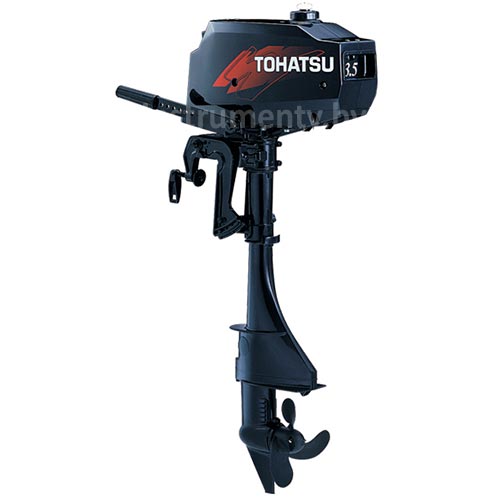
Advantages of Tokhastu M3.5
- Two stroke motor
- Optimal power
- Light weight
- Reliability,
- Low cost
- High reliability,
- Assembly Japan
Disadvantages of Tohatsu M3.5
- Plastic screw
- No remote tank
- No reverse gear
- Tohatsu mfs 3.5 BS
Advantages of Tohastu mfs3.5
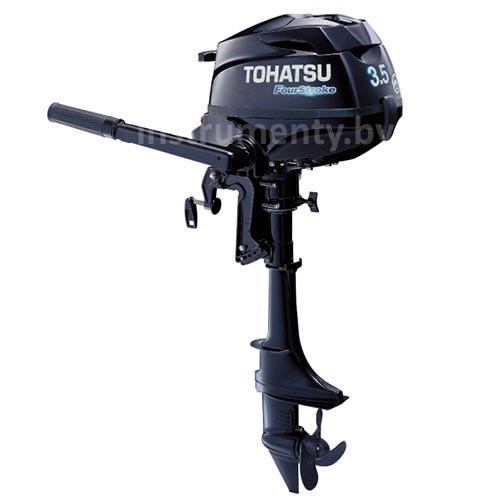
- Low fuel consumption
- Optimal power
- Light weight
- Lowest cost among 3.5 hp engines. 4T
- High reliability,
- Availability of neutral and forward gear
- Assembly Japan
Disadvantages of Tohatsu mfs3.5
- Plastic screw
- No reverse gear
- Mercury 3.3M

- Push-pull
- Water cooling
- One of the most durable models of low-power motors
- Light weight
- Proprietary injection system facilitating quality work engine,
- Low cost,
- Assembly Japan
disadvantages of Mercury 3.3 M
- Forward transmission only
- No reverse gear
- No remote tank
- Higher cost than tohatsu m3.5 two-stroke engines
- Honda Bf 2.3
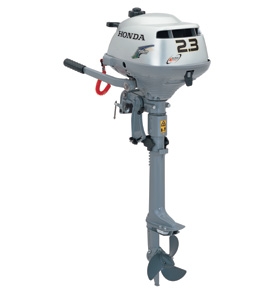
Advantages of Honda bf2.3
- A more environmentally friendly four-stroke engine
- Lowest fuel consumption of all models
- Optimal power
- Light weight
- Reliability and high-quality assembly
- One of the lowest cost among 2 hp motors. 4T
- High reliability,
- Availability of neutral gear and forward gear,
- Assembly Japan
Disadvantages of Tohatsu bf2.3
- Plastic screw
- Air cooling
- Higher weight compared to 2t Tohatsu 3.5 hp.
- No reverse gear
The most popular 2t motors with a power of 5 hp.
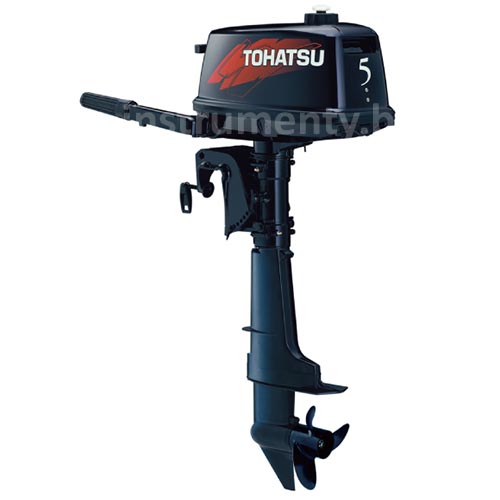
The most popular 4t motors are 5 hp.
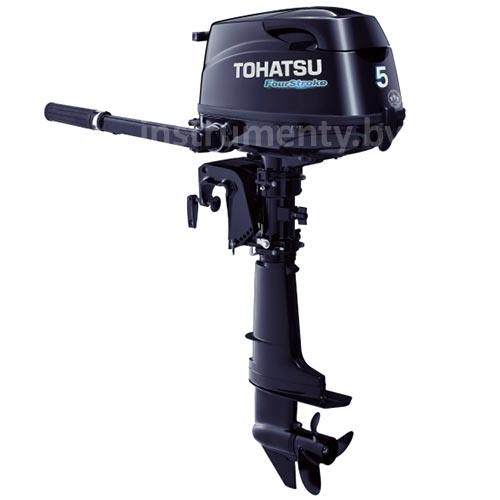
2 t motors

4t motors
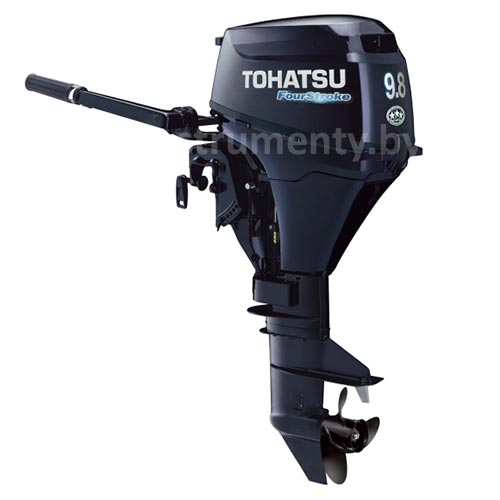
2 t motors

4t motors
Why is it important to choose the right balance motor power for a boat? An engine that is too weak will experience constant overloads, which will inevitably lead to breakdowns and rapid failure. An engine that is too powerful will become a source of danger primarily for the passengers themselves, since the ship will be difficult to control. In this segment, two-stroke models are extremely rare due to their noise and environmental friendliness. Most popular models
2 t motors
- Tohatsu M 40CEPS is the undisputed sales leader among 2 engines with power from 15 hp.
- Tohatsu M40 CS is one of the most reliable engines today. Legendary model
4t motors

Outboard motor leg length
The length of the driftwood directly affects the maneuverability and maneuverability of the boat, as well as its speed. If you buy a motor with a leg that is too long, it will serve as an additional obstacle to movement, the boat will cling to the bottom and slow down.
The length of the draywood is the distance from the bracket to the cavitation plate. Ideally, it should correspond to the dimensions of the transom with a difference of no more than 2 cm. The length of the transom is the height from the top edge of the transom to the bottom of the boat. To ensure correct measurements, it is better to measure on the ground.
There are boats with an adjustable transom, which allows you to adjust the height to fit an existing motor. But you need to be careful and make sure that in any position the motor is installed correctly and does not interfere with movement. Leg length (deadwood) is standardized in most cases and has international sizes:
- S -15 inches -381 mm
- L - 20 inches - 508 mm
- XL (Ul) - 25 inches -635 mm
- XXL -30 inches -762 mm
However, it should be noted that quite often, in motors supplied to the CIS, the leg length (deadwood) may differ slightly.
- for most Mercury models it is 435 mm
- Tohatsu, almost all models, have a foot size S is 435 mm
- Yamaha has from 8 to 15 hp. sizes may vary from 436 to 440 mm.
This can be argued by the optimal driving performance of the engine. The length of the boat transom and motor is usually standardized, i.e. corresponds international standards(error no more than +- 1 mm).
Which boat motor is better: two-stroke or four-stroke?
To an unknowing person, the difference between these types of engines may seem small, but it is still important to know and understand what the advantages and disadvantages of each of them are.
Two-stroke engines. They have high power and low weight, so they are mainly used on small and medium-sized boats. They quickly develop speed and are unpretentious in maintenance and repair. Their main advantage is low price and a large range of models in all power ranges.
But these engines are very power hungry, so installing them on large ships is not very profitable. Because of high level exhaust gases today it is prohibited to use them on many reservoirs, lakes and rivers. In addition, they make a lot of noise, so they are not very suitable for a quiet walk, relaxation or fishing.
Four-stroke engines. Economical and environmentally friendly. The low level of emissions will allow the use of such an engine on any body of water. In addition, they have high efficiency, which greatly affects fuel economy. Smooth engine operation, low noise levels, the ability to drive a boat at low speeds, and the absence of harmful emissions make this engine convenient to use even for beginners. In terms of reliability, four-stroke engines are superior to their two-stroke counterparts, so they break down much less often and require repairs.
The disadvantages of this class of motors are their heavy weight and price. Due to their size and weight, four-stroke engines are almost impossible to use on small boats. And the high price makes the purchase an expensive pleasure.
To better understand the advantages and disadvantages of four-stroke and two-stroke outboard engines, read the article. It is also important to understand the motor designation systems, i.e. to know what this or that letter means, read more about this here.

